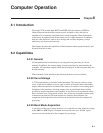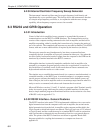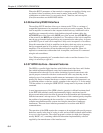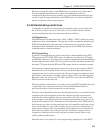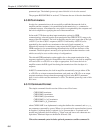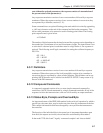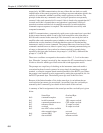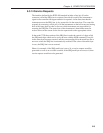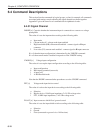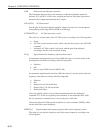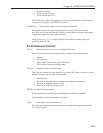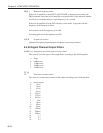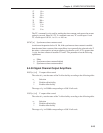
6-8
Chapter 6, COMPUTER OPERATION
respectively. In GPIB communications, the use of these bits can lead to a useful
simplification of the control program by providing a response subroutine which is the
same for all commands, whether or not they send a response over the bus. The
principle is that after any command is sent, serial poll operations are repeatedly
executed. After each operation bit 0 is tested; if this is found to be negated then bit 7
is tested, and if this is asserted then a read operation is performed. Serial poll
operations continue until the lock-in amplifier asserts bit 0 to indicate that the
command-response sequence is complete. This method deals successfully with
compound commands.
In RS232 communications, comparatively rapid access to the status byte is provided
by the prompt character which is sent by the lock-in amplifier at the same time as
bit 0 becomes asserted in the status byte. This character is sent out by the lock-in
amplifier after each command response (whether or not the response includes a
transmission over the interface) to indicate that the response is finished and the
instrument is ready for a new command. The prompt takes one of two forms. If the
command contained an error, either in syntax or by a command parameter being out
of range, or alternatively if an overload or reference unlock is currently being
reported by the front-panel indicators, the prompt is ? (ASCII 63). Otherwise the
prompt is * (ASCII 42).
These error conditions correspond to the assertion of bits 1, 2, 3 or 4 in the status
byte. When the ? prompt is received by the computer, the ST command may be issued
in order to discover which type of fault exists and to take appropriate action.
The prompts are a rapid way of checking on the instrument status and enable a
convenient keyboard control system to be set up simply by attaching a standard
terminal, or a simple computer-based terminal emulator, to the RS232 port. Where
the prompt is not required it can be suppressed by setting the noprompt bit, bit 4 in
the RS232 parameter byte. The default (power-up) state of this bit is zero.
Because of the limited number of bits in the status byte, it can indicate that an
overload exists but cannot give more detail. An auxiliary byte, the overload byte
returned by the N command, gives details of the location of the overload.
A summary of the bit assignments in the status byte and the overload byte is given
below.
Status Byte Overload Byte
bit 0 command complete not used
bit 1 invalid command CH1 output overload
bit 2 command parameter error CH2 output overload
bit 3 reference unlock Y output overload
bit 4 overload X output overload
bit 5 new ADC values available
after external trigger not used
bit 6 asserted SRQ input overload
bit 7 data available reference unlock




